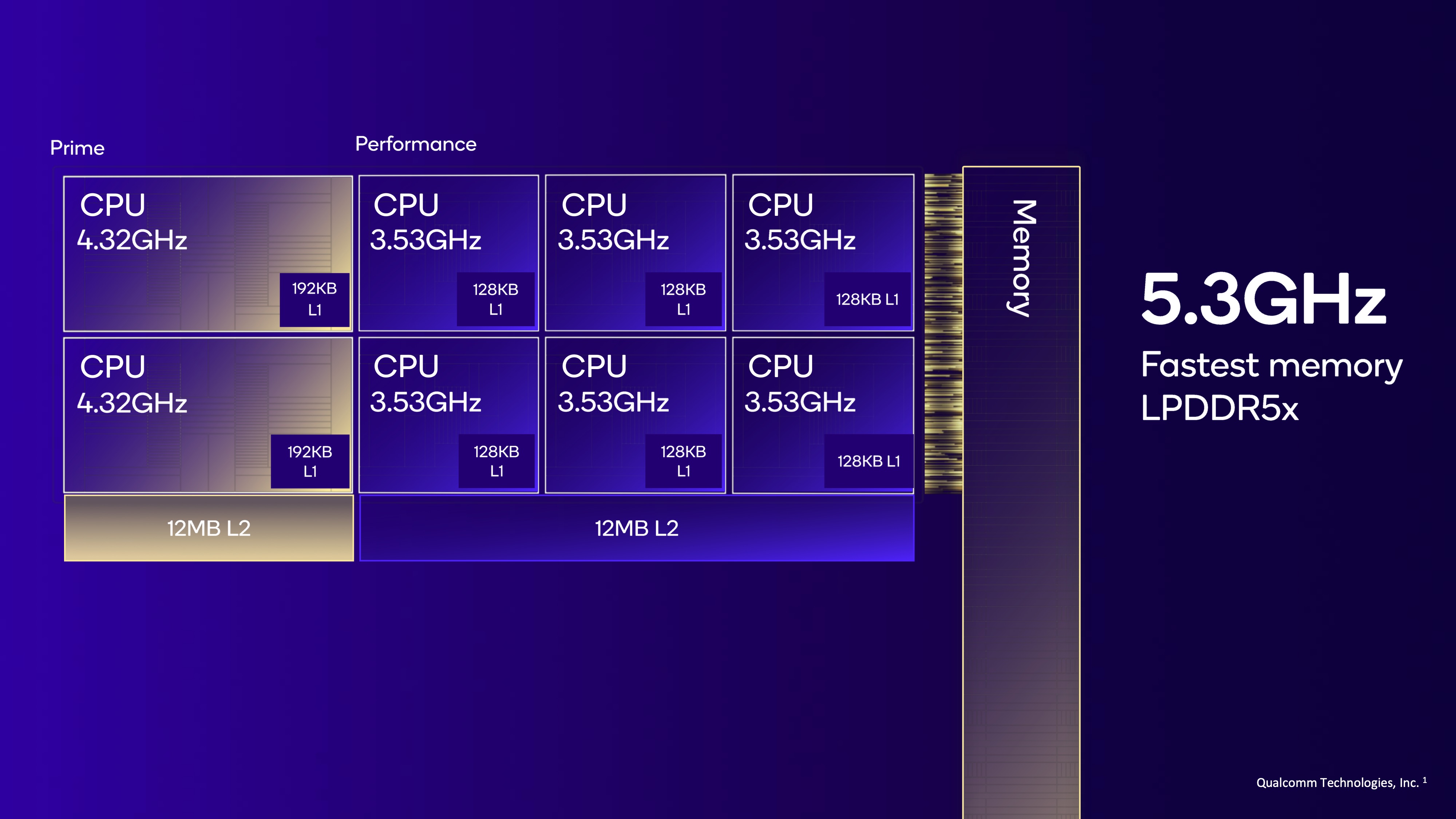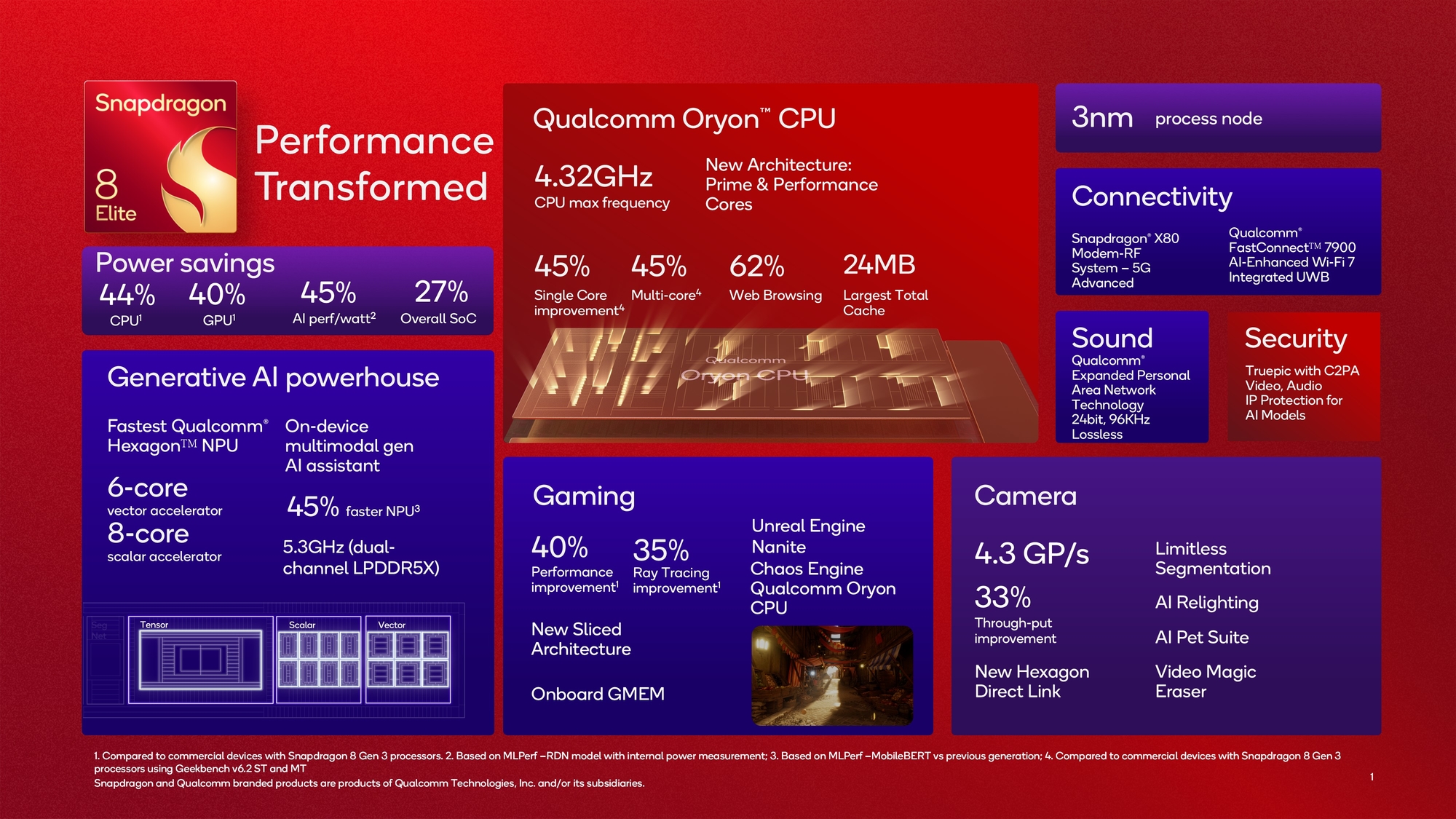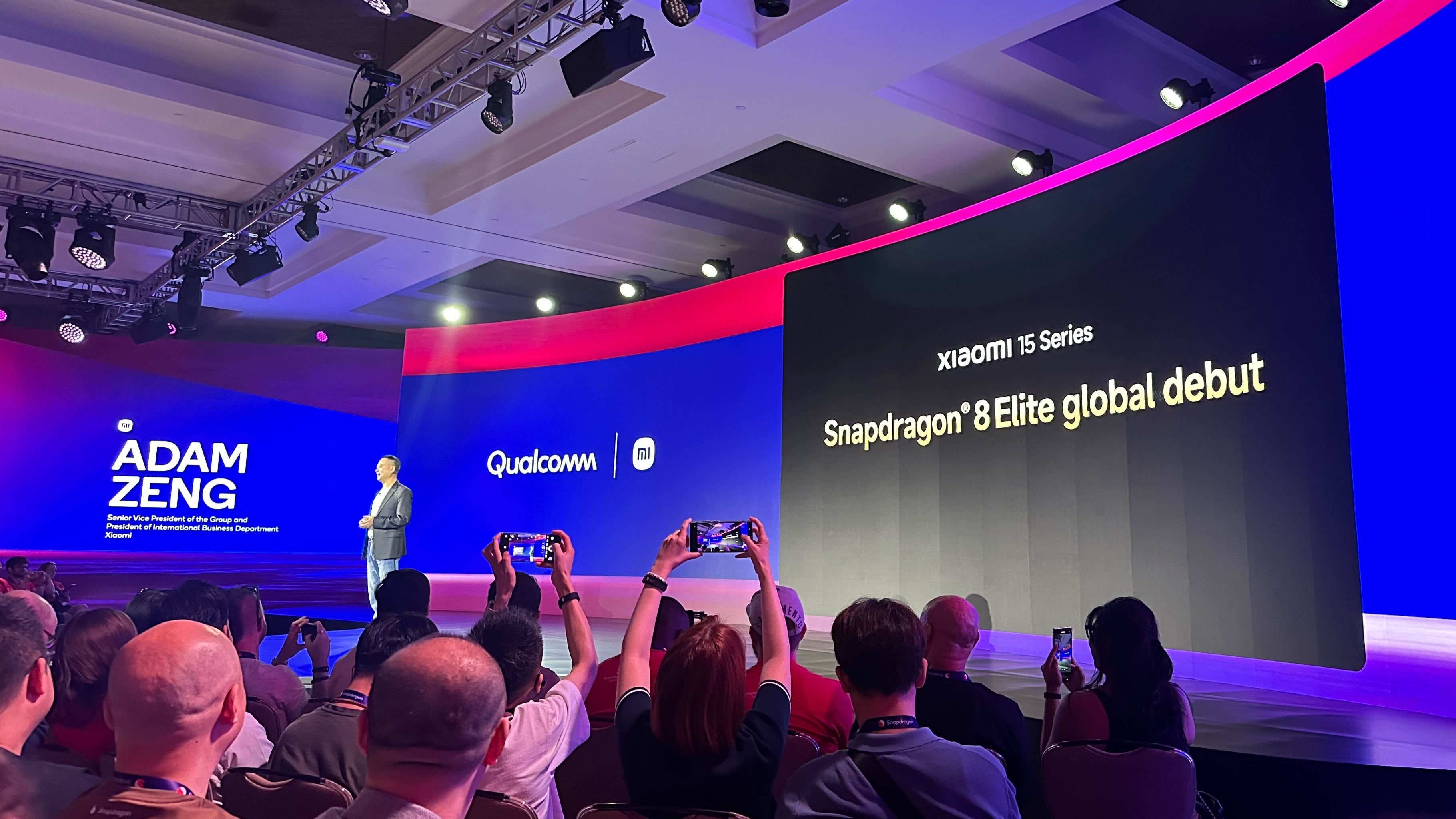Qualcomm unveiled its Snapdragon 8 Elite platform in Hawaii, and a key talking point this year is the manufacturer’s return to custom cores. After nearly a decade of semi-custom designs, Qualcomm is once again leveraging a fully custom architecture, and that is immensely exciting.
As you can imagine, Qualcomm is touting heady gains across the board with the Snapdragon 8 Elite, and with a node shift to 3nm, the chipset may just be one of the best we’ve gotten in recent years. Here’s everything you need to know about the Snapdragon 8 Elite, and how it compares to the Snapdragon 8 Gen 3 and MediaTek’s Dimensity 9400.
Snapdragon 8 Elite vs. 8 Gen 3 vs. Dimensity 9400

Interestingly, Qualcomm is changing how it uses cores in the Snapdragon 8 Elite, with the platform featuring eight performance cores as standard. You don’t get the usual efficiency cores that do a bulk of the mundane tasks, with Qualcomm emulating MediaTek in this regard. If you want to know more about why Qualcomm ditched efficiency cores with this generation, my colleague Michael Hicks talked to Qualcomm engineers about why it’s a big deal.
Let’s take a look at how the Snapdragon 8 Elite compares to the Snapdragon 8 Gen 3 and MediaTek’s Dimensity 9400:
| Category | Snapdragon 8 Elite | Snapdragon 8 Gen 3 | MediaTek Dimensity 9400 |
|---|---|---|---|
| CPU | 2 x 4.32GHz Oryon, 6 x 3.53GHz Oryon | 1 x 3.3GHz Cortex X4, 3 x 3.2GHz Cortex A720, 3 x 3.0GHz Cortex A720, 2 x 2.0GHz Cortex A520 | 1 x 3.63GHz Cortex X925, 3 x 3.3GHz Cortex X4, 4 x 2.4GHz Cortex A720 |
| GPU | Adreno, 40% increased performance over 8 Gen 3, Unreal Engine 5.3, HDR gaming | Adreno 750, Unreal Engine 5 | Arm Mali-G925 Immortalis MP12. MediaTek Frame Rate Converter |
| Connectivity | Qualcomm FastConnect 7900, 5.8Gbps Wi-Fi 7, Bluetooth 6.0, UWB | Qualcomm FastConnect 7800, 5.8Gbps Wi-Fi 7, Bluetooth 5.4 | 7.3Gbps Wi-Fi 7, Bluetooth 5,4 |
| 5G Modem | X80 5G Modem, 10Gbps downlink, 3.5Gbps uplink | X75 5G Modem, 10Gbps downlink, 3.5Gbps uplink | MediaTek 3GPP Release-17 5G modem, 7Gbps downlink, |
| DSP | Hexagon NPU, 45% increased performance over 8 Gen 3, multimodal AI | Hexagon NPU | MediaTek 8th Generation NPU, Dimensity Agentic AI Engine, multimodal AI |
| Camera features | Qualcomm Spectra AI 18-bit ISP, limitless real-time semantic segmentation, 48MP triple camera with zero shutter lag, 108MP single camera with zero shutter lag, 320MP photo, 10-bit HEIF, Dolby HDR, HDR video, massive multi-frame noise reduction with AI | Qualcomm Spectra AI 18-bit ISP, limitless real-time semantic segmentation, 36MP triple camera with zero shutter lag, 108MP single camera with zero shutter lag, 200MP photo, 10-bit HEIF, Dolby HDR, HDR video, multi-frame noise reduction | Imagiq 1090, 320MP photo |
| Video | 8K HDR at 60fps, 4K at 120fps | 8K HDR at 30fps, 4K at 120fps | 8K HDR at 60fps, 4K at 120fps |
| Display | 4K @ 60Hz, QHD+ @ 240Hz | 4K @ 60Hz, QHD+ @ 144Hz | 4K @ 60Hz, QHD+ @ 144Hz |
| RAM | LPDDR5X, memory bandwidth up to 5.3Gbps | LPDDR5X, memory bandwidth up to 4.7Gbps | LPDDR5X, memory bandwidth up to 10Gbps |
| Manufacturing node | TSMC 3nm | TSMC 4nm | TSMC 4nm |
Qualcomm significantly boosted the clocks of its cores, with the main cores now going up to 4.32GHz — nearly 1GHz more than that of the 8 Gen 3. This is because of the node shift to 3nm; Qualcomm is finally using TSMC’s 3nm node, and that allows the manufacturer to deliver increased frequencies while still maintaining stable thermals.
Qualcomm is also touting heady gains on the gaming side of things, along with a new neural engine, and AI-assisted tweaks to its imaging platform.
Heading back to custom designs with Oryon CPU

Qualcomm has been switching up the core configuration of its chipsets, and the Snapdragon 8 Elite comes with the biggest shift in this regard in nearly a decade. Because of the use of second-gen Oryon cores, Qualcomm is able to deliver incredible gains, with the brand touting a massive 45% gain in performance over the 8 Gen 3 in single-core and multi-core workloads.
What’s also interesting is that the 8 Elite is 44% more efficient while performing the same workloads as the 8 Gen 3, and that’s more than a generational increase. Qualcomm used semi-custom design in recent years, where it would basically license Arm cores and add a few custom features, while retaining Kryo branding.
However, with the Oryon cores, Qualcomm is using Arm’s architectural license; it takes the instruction set from Arm and then builds the core from the ground up, allowing it much better flexibility. The return to custom cores gives the Snapdragon 8 Elite a sizeable advantage, and close the gap to Apple’s silicon.
In fact, this is similar to Apple’s approach with its A series chipsets, and although Qualcomm used to do the same in the past, we haven’t seen fully custom cores from the chip vendor following the Snapdragon 805. Qualcomm is once again able to deliver custom designs thanks to its acquisition of Nuvia back in 2021.
What does the switch to the custom architecture entail? Well, Qualcomm is touting incredible gains in performance over the 8 Gen 3, and that should make a difference in real-world use. Qualcomm is just using two core clusters this time, and that allows the brand to tailor tasks with better efficiency — we got four clusters last year.
Another factor to consider is the 4.32GHz frequency on the main cores; this is considerably more than previous years, and while the cores only go up to the maximum frequency in very short bursts, it should still make a difference.
Taking gaming to new heights with Adreno GPU

Coming to the gaming side of things, the Snapdragon 8 Elite switches up the naming convention once again, with Qualcomm just going with Adreno branding without any model numbers. Again, we get heady figures, with Qualcomm touting a 40% increase in performance. What is much more interesting is that the GPU is 40% more efficient at the same tasks as the 8 Gen 3.
The GPU also includes increased video memory, and there’s a 35% uptick in ray tracing along with the ability to use Unreal Engine 5’s Nanite engine. All of these features are undoubtedly great, but what I’m interested in knowing is how phones with the platform handle sustained gaming; this has been an issue on the 8 Gen 3, and while there was no shortage of power, it led to overheating and thermal constraints.
It remains to be seen if those issues have been mitigated with this generation, and if we actually get usable titles that have ray tracing enabled.
AI once again takes center stage

You can’t go two minutes in the tech industry without a mention of AI, and Qualcomm is rolling out several upgrades in this area as well. The Hexagon NPU has a 45% increase in AI performance, along with 45% better efficiency per watt. It integrates multimodal AI engines, including Gemini Nano.
While I don’t see the point of mobile AI just yet, what is interesting is how Qualcomm is leveraging machine learning into its imaging platform. The Spectra AI ISP now includes limitless real-time semantic segmentation, and that should deliver better portrait shots. You get to see these benefits in videos as well, and that’s just great.
Coming to a phone near you

Xiaomi is a launch partner for Qualcomm, and the Xiaomi 15 is the first phone to feature the Snapdragon 8 Elite silicon globally. OnePlus isn’t far behind with the OnePlus 13, which is launching in China on October 31.
Honor is debuting the Magic 7 series with the Snapdragon 8 Elite, and we have ASUS, Nubia, iQOO, and other manufacturers getting in on the action. We usually need to wait until the end of the year to get devices based on Qualcomm’s latest silicon, but it looks like some device makers are targeting an early release, so we don’t need to wait to get hands on the Snapdragon 8 Elite.
